Improvement of the Cracking Moment-Based Asphalt Mixture Splitting Test Method and Splitting Strength Research
Abstract
:1. Introduction
2. Materials and Testing Methods
2.1. Materials
2.2. Test Equipment and Process
2.3. Judgment of Splitting Failure
2.4. Results of the Conventional Splitting Test
2.5. Shortcomings of the Conventional Splitting Test
3. Influence of the Splitting Test Conditions and Test Improvement
3.1. Effect of the Specimen Size
3.2. Effect of the Test Loading Fixture
3.3. Improvement of the Splitting Test Method
- (1)
- It is clear from Figure 17 that the enhanced splitting result of the “0.3 mm rubber gasket + 12.7 mm arc-shaped batten” strategy better characterizes the elastic deformation stage in the stress–strain curve than previous techniques, and the test results are generally more trustworthy.
- (2)
- In the cracking test, the “0.3 mm rubber gasket + 12.7 mm arc-shaped batten” can successfully lessen the failure time difference and accomplish the ideal result in which the “center of the circle cracks first”. It also has the most logical strength data, a high success rate, and little data dispersion from the perspective of data analysis.
- (3)
- By comparing the splitting test results for rubber gaskets of various thicknesses, it is discovered that “0.3 mm rubber gasket + 12.7 mm arc-shaped batten” is the most economical and cost-effective.
3.4. Research on the Strength Model of the Asphalt Mixture Splitting Test
4. Analytical Comparison between the Splitting Test and the Direct Tensile Test at Different Loading Rates
5. Conclusions and Recommendations
- According to the “China highway code”, the splitting test of asphalt mixtures was carried out. The end of the sample often breaks before the center of the circle, resulting in stress concentration, and it deviates from the perfect stress state specified in the specifications, resulting in significant errors in the calculation of the splitting strength.
- When using the test strategies of a “35 mm specimen thickness” and “0.3 mm rubber gasket + 12.7 mm arc-shaped batten”, the outcome of the “first crack at the center of the circle” is essentially realized.
- The octahedral strength theory proves that the improved stress point is closer to the existing failure criterion, indicating that the improved splitting test is closer to the ideal failure stress state. In addition, it also successfully reduces the discreteness of the data and improves the success rate of the testing.
- Based on the test results, it is found that there is a power function relationship between the strength and the loading rate, and the unified equations of the tensile and splitting strength rate are constructed. This not only improves the operability but also provides a reference for engineering applications, so that researchers can use the splitting test to quickly estimate the tensile strength of asphalt mixtures.
Author Contributions
Funding
Data Availability Statement
Conflicts of Interest
References
- He, Z.; Xie, T.; Yu, H.; Ge, J.; Dai, W.J.C.; Materials, B. Evaluation of quantum dot composite graphene/Titanium oxide enhanced UV aging resistance modified asphalt. Constr. Build. Mater. 2023, 408, 133732. [Google Scholar] [CrossRef]
- Ren, S.; Liu, X.; Lin, P.; Wang, H.; Fan, W.; Erkens, S.J.C.; Materials, B. The continuous swelling-degradation behaviors and chemo-rheological properties of waste crumb rubber modified bitumen considering the effect of rubber size. Constr. Build. Mater. 2021, 307, 124966. [Google Scholar] [CrossRef]
- Li, M.; Ren, S.; Liu, X.; Wu, Z.; Zhang, H.; Fan Xu, J.J.M. A Comprehensive Study on the Rejuvenation Efficiency of Compound Rejuvenators for the Characterization of the Bituminous Binder, Mortar, and Mixture. Materials 2022, 15, 5458. [Google Scholar] [CrossRef] [PubMed]
- Li, S.; Sun, Y.; Xu, L.; Yu, S.; Liang, X.; Ye, J.J.B. Asphalt Layer Cracking Behavior and Thickness Control of Continuously Reinforced Concrete and Asphalt Concrete Composite Pavement. Buildings 2022, 12, 1138. [Google Scholar] [CrossRef]
- Takaikaew, T.; Hoy, M.; Horpibulsuk, S.; Arulrajah, A.; Mohammadinia, A.; Horpibulsuk, J.J.H. Performance improvement of asphalt concretes using fiber reinforcement. Heliyon 2021, 7, e07015. [Google Scholar] [CrossRef]
- Ahmed, K.U.; Geremew, A.; Jemal, A.J.H. The comparative study on the performance of bamboo fiber and sugarcane bagasse fiber as modifiers in asphalt concrete production. Heliyon 2022, 8, e09842. [Google Scholar] [CrossRef]
- Carneiro, F.C. A new method to determine the tensile strength of concrete. In Proceedings of the 5th Meeting of the Brazilian Association for Technical Rules, Lisbon, Portugal, 16 September 1943. [Google Scholar]
- Akazawa, T. New test method for evaluating internal stress due to compression of concrete (the splitting tension test) (part 1). J. Jpn. Soc. Civ. Eng. 1943, 29, 777–787. [Google Scholar]
- Fahimifar, A.; Malekpour, M. Experimental and numerical analysis of indirect and direct tensile strength using fracture mechanics concepts. Bull. Eng. Geol. Environ. 2012, 71, 269–283. [Google Scholar] [CrossRef]
- Małyszko, L.; Kowalska, E.; Bilko, P. Splitting tensile behavior of autoclaved aerated concrete: Comparison of different specimens’ results. Constr. Build. Mater. 2017, 157, 1190–1198. [Google Scholar] [CrossRef]
- ASTM D3967-16; Standard Test Method for Splitting Tensile Strength of Intact Rock Core Specimens. ASTM International: West Conshohocken, PA, USA, 2008.
- Garcia-Fernandez, C.; Gonzalez-Nicieza, C.; Alvarez-Fernandez, M.; Gutierrez-Moizant, R. Analytical and experimental study of failure onset during a Brazilian test. Int. J. Rock Mech. Min. Sci. 2018, 103, 254–265. [Google Scholar] [CrossRef]
- Gutiérrez-Moizant, R.; Ramírez-Berasategui, M.; Santos-Cuadros, S.; García-Fernández, C.J.R.M.; Engineering, R. Computational verification of the optimum boundary condition of the Brazilian tensile test. Rock Mech. Rock Eng. 2018, 51, 3505–3519. [Google Scholar] [CrossRef]
- Erarslan, N.; Williams, D.J. Experimental, numerical and analytical studies on tensile strength of rocks. Int. J. Rock Mech. Min. Sci. 2012, 49, 21–30. [Google Scholar] [CrossRef]
- Gutiérrez-Moizant, R.; Ramírez-Berasategui, M.; Sánchez-Sanz, S.; Santos-Cuadros, S. Experimental verification of the boundary conditions in the success of the Brazilian test with loading arcs. An uncertainty approach using concrete disks. Int. J. Rock Mech. Min. Sci. 2020, 132, 104380. [Google Scholar] [CrossRef]
- Sarfarazi, V.; Haeri, H.; Ebneabbasi, P.; Shemirani, A.B.; Hedayat, A. Determination of tensile strength of concrete using a novel apparatus. Constr. Build. Mater. 2018, 166, 817–832. [Google Scholar] [CrossRef]
- Jonsén, P.; Häggblad, H.; Sommer, K. Tensile strength and fracture energy of pressed metal powder by diametral compression test. Powder Technol. 2007, 176, 148–155. [Google Scholar] [CrossRef]
- Zhang, C.; Yu, H.; Zhu, X.; Yao, D.; Peng, X.; Fan, X. Unified Characterization of Rubber Asphalt Mixture Strength under Different Stress Loading Paths. J. Mater. Civ. Eng. 2024, 36, 04023498. [Google Scholar] [CrossRef]
- Qian, G.; Luo, X.; Yu, H.; Shi, C.; Zhang, C.; Li, P. Evaluation of Material Composition on the Shear Performance of Asphalt Mixtures under Different Test Conditions. Buildings 2023, 13, 936. [Google Scholar] [CrossRef]
- Wang, P.; Elchalakani, M.; Zhou, Y.; Yan, S.-T.; Li, S.-B. A study on the influences of a hygrothermal environment on the compressive strength and failure criteria of asphalt mixtures based on true triaxial tests. Heliyon 2022, 8, e10060. [Google Scholar] [CrossRef] [PubMed]
- Huang, T.; Tang, Y.; Li, M.; Chen, J.; Xie, J.; Lv, S.; Qian, G.; Liu, H. Study on multiple failure criteria of asphalt mixtures in complex stress states. J. Mater. Civ. Eng. 2021, 33, 04021272. [Google Scholar] [CrossRef]
- He, Y.; Lv, S.; Wang, Z.; Ma, H.; Lei, W.; Pu, C.; Meng, H.; Xie, N.; Peng, X. Research on the Modulus Decay Model under a Three-Dimensional Stress State of Asphalt Mixture during Fatigue Damage. Buildings 2023, 13, 2570. [Google Scholar] [CrossRef]
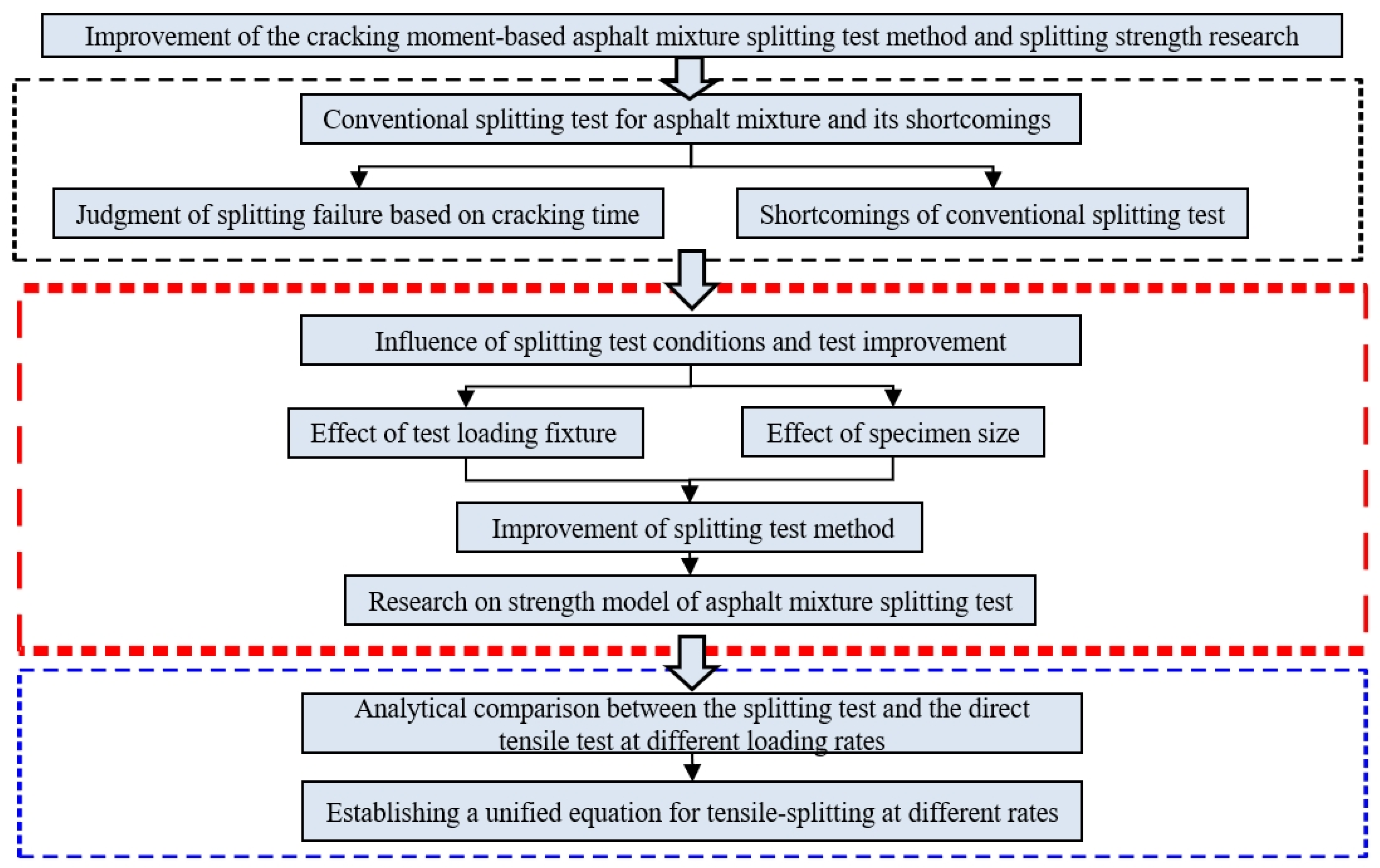
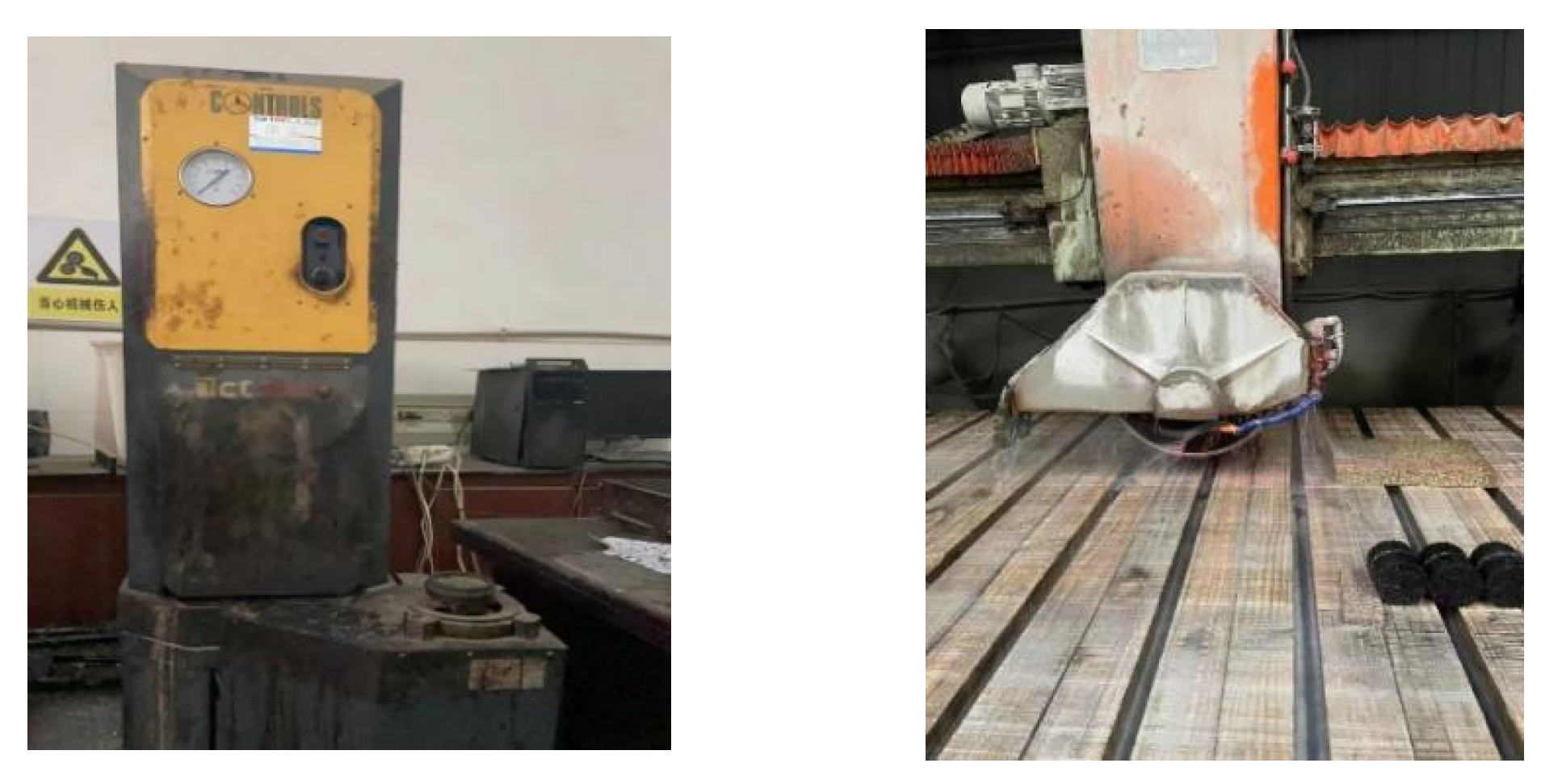
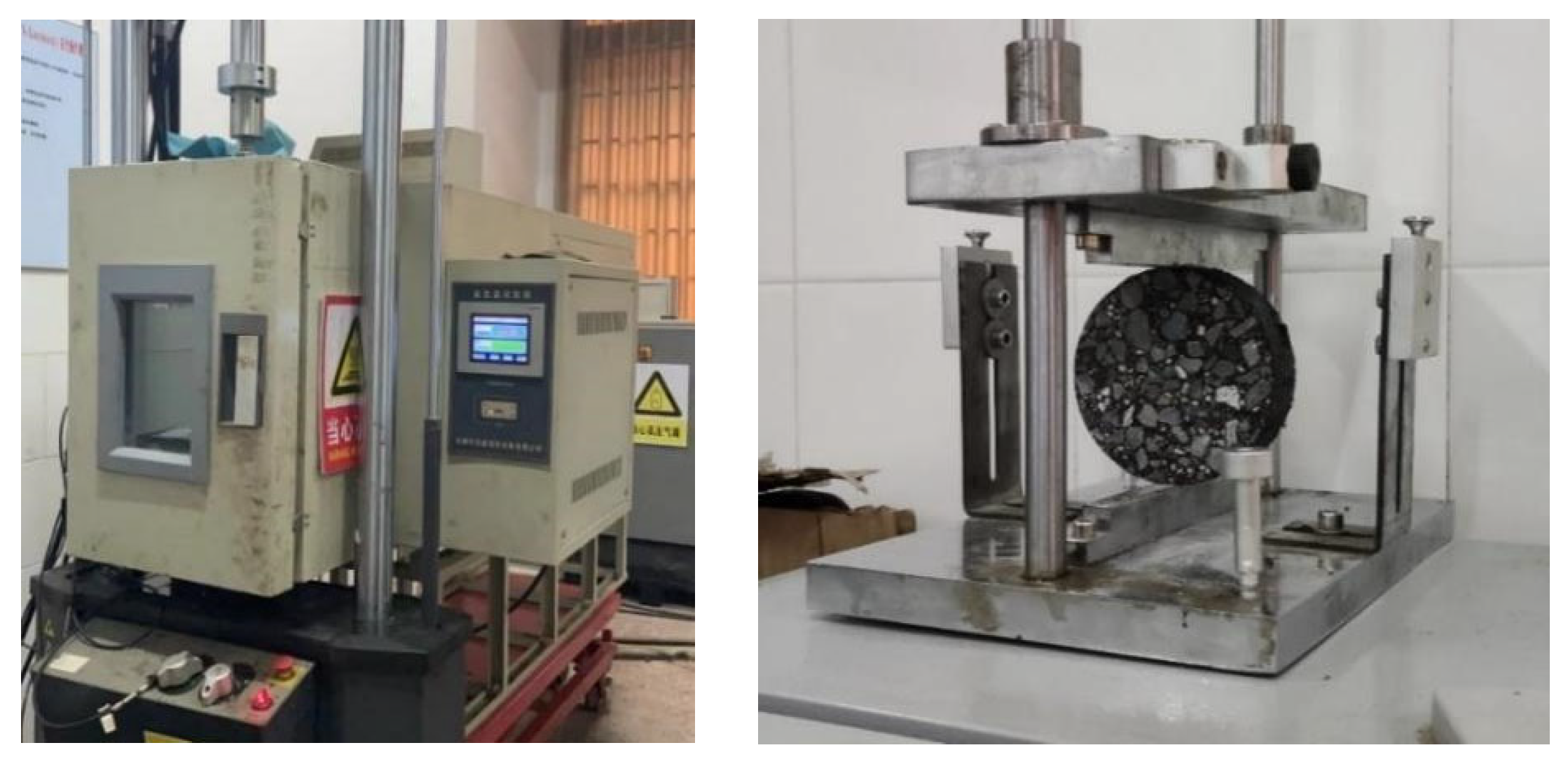

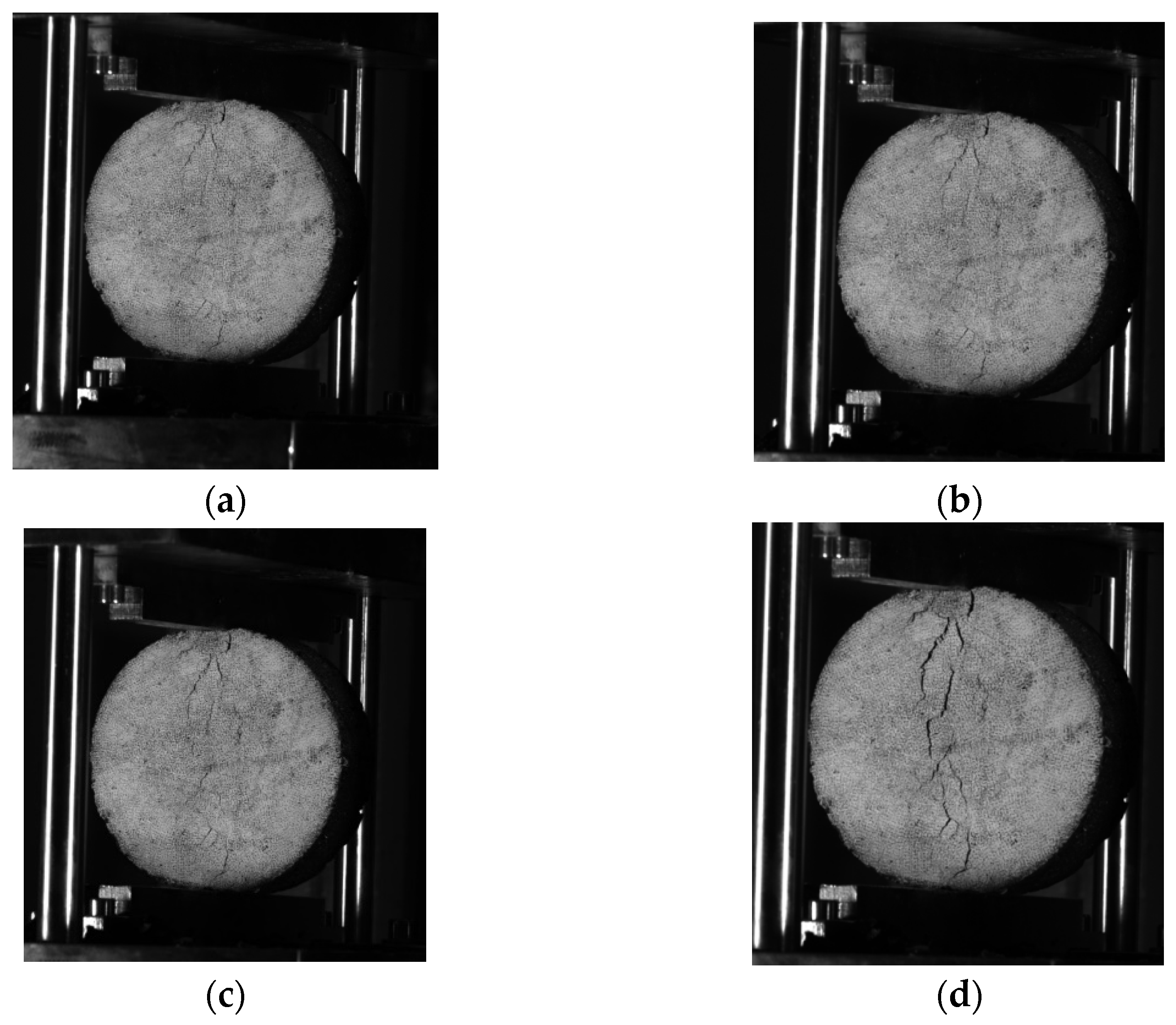
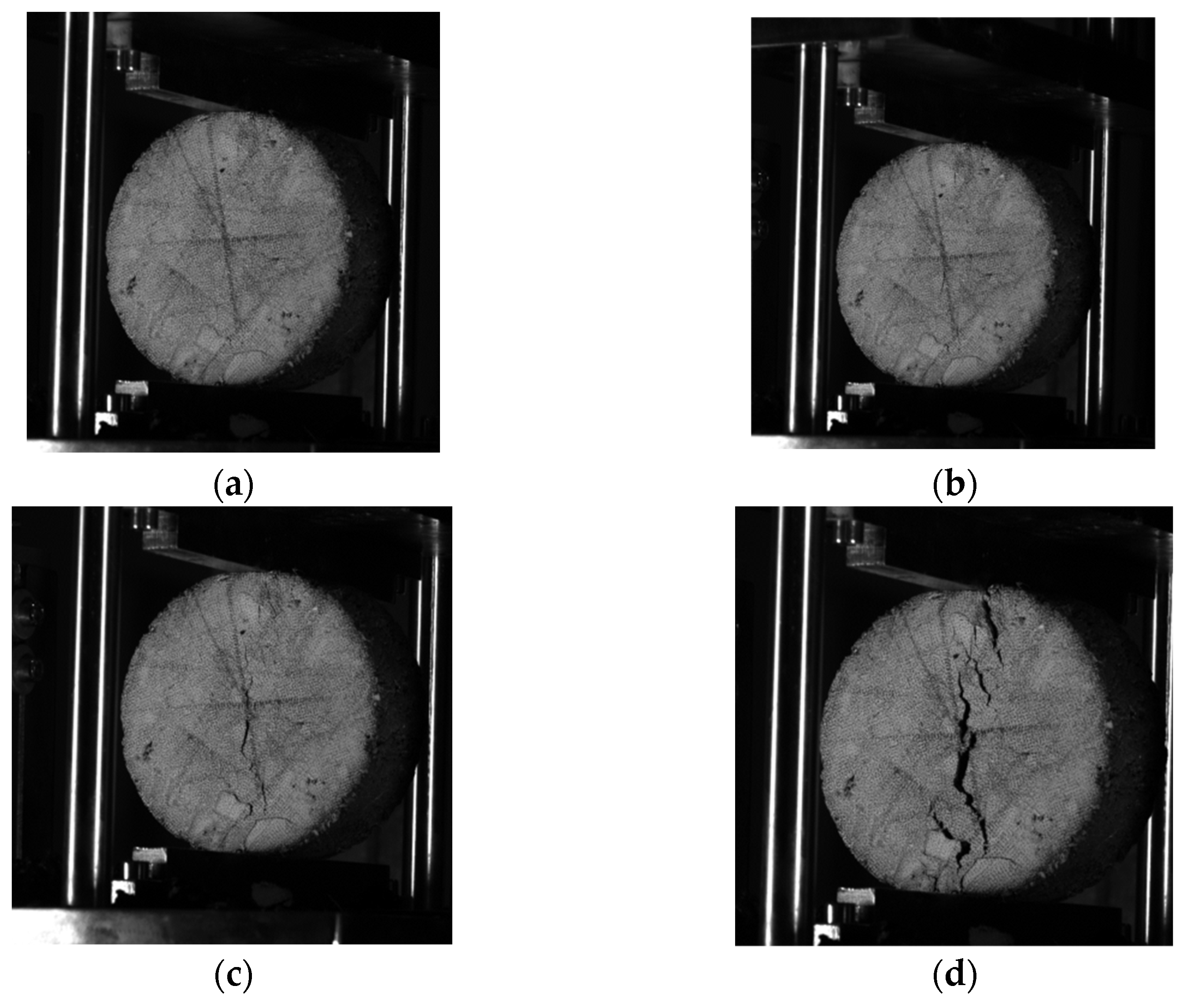
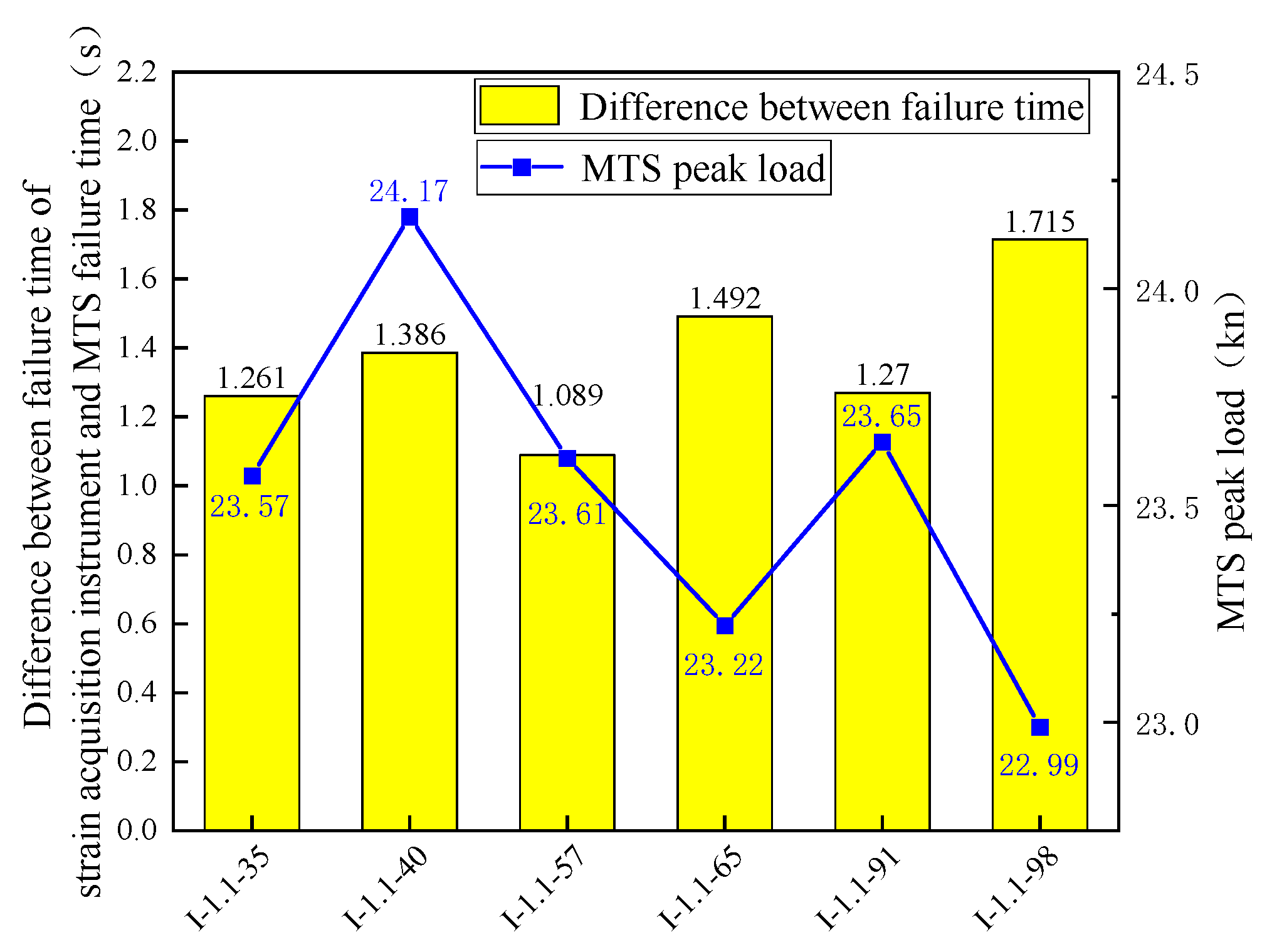


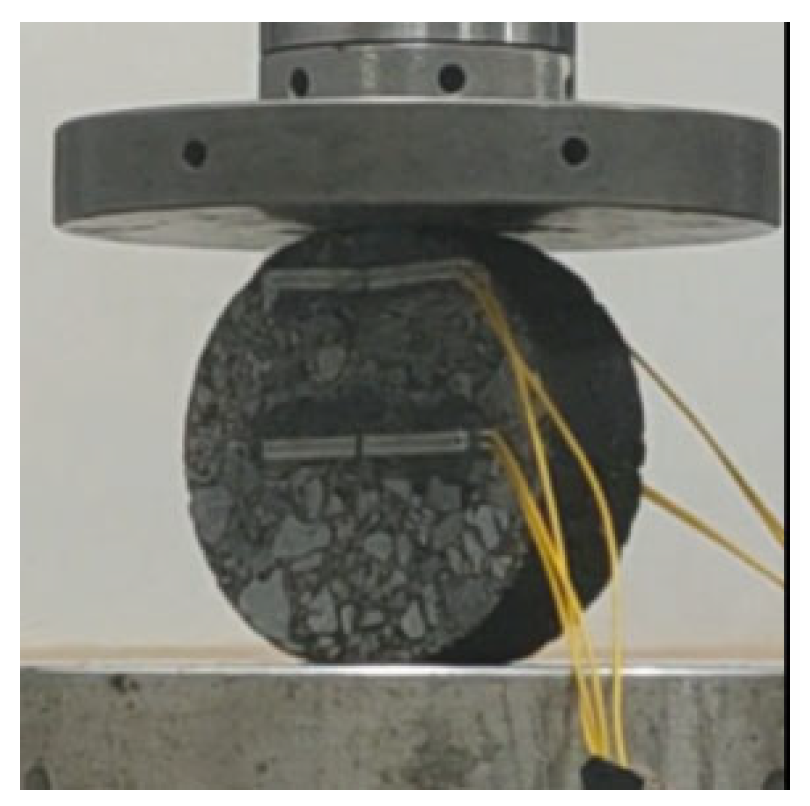
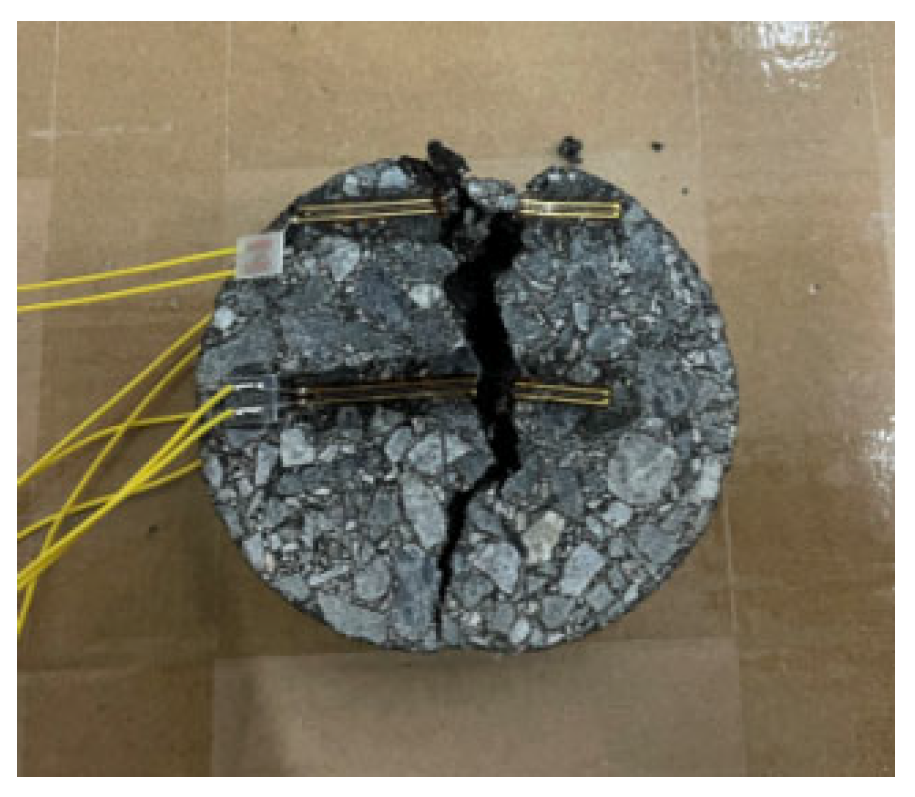

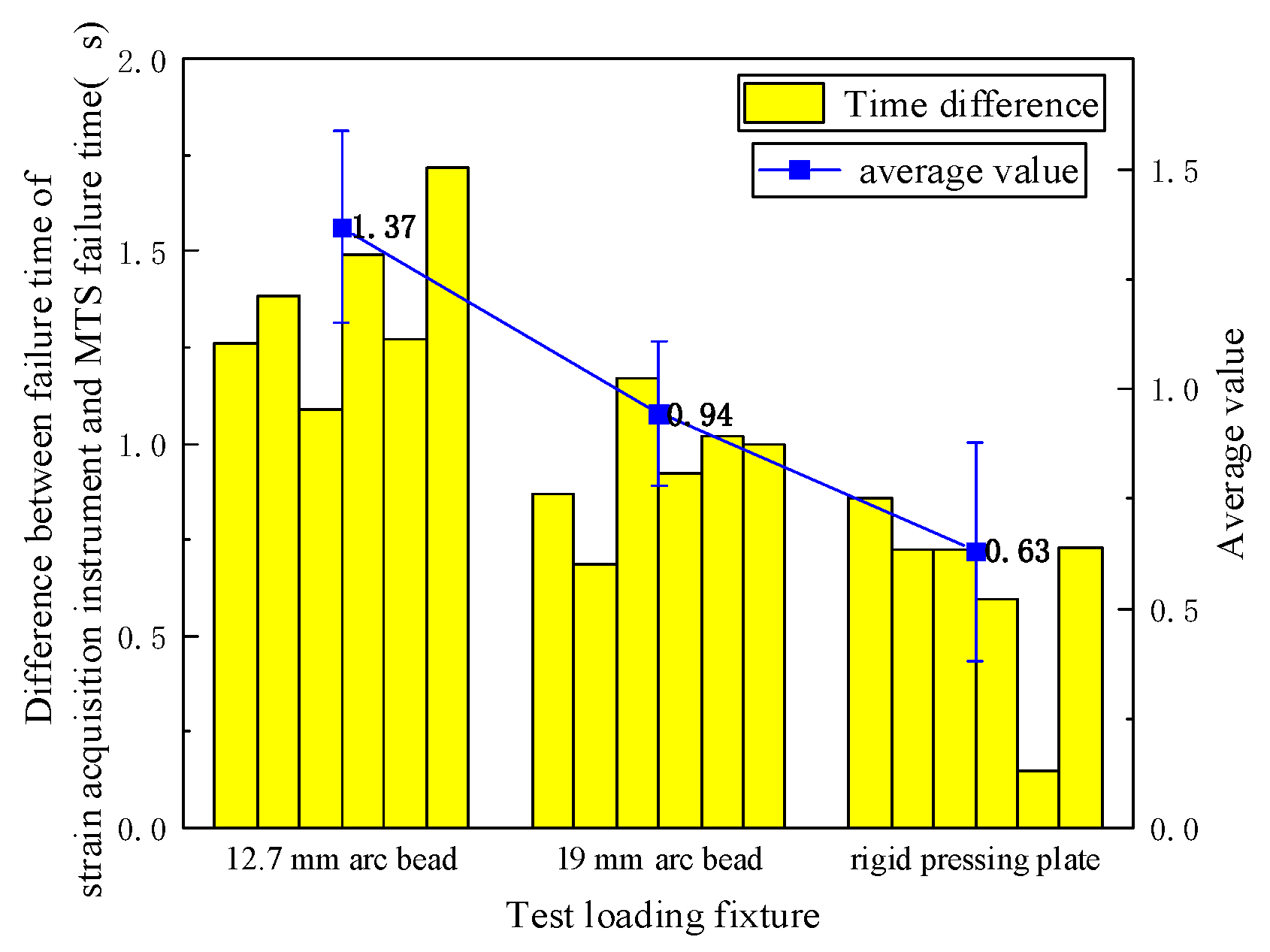



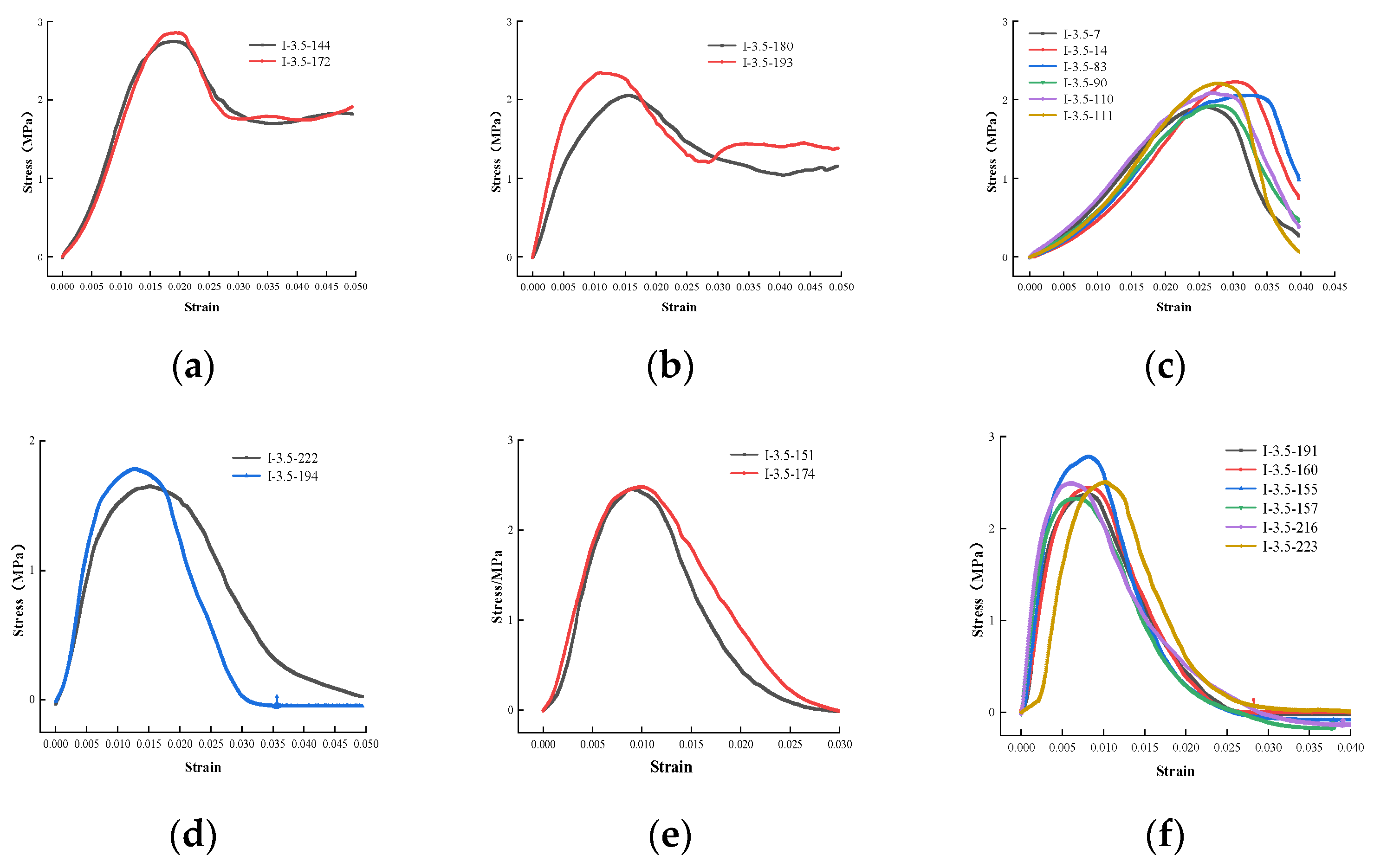




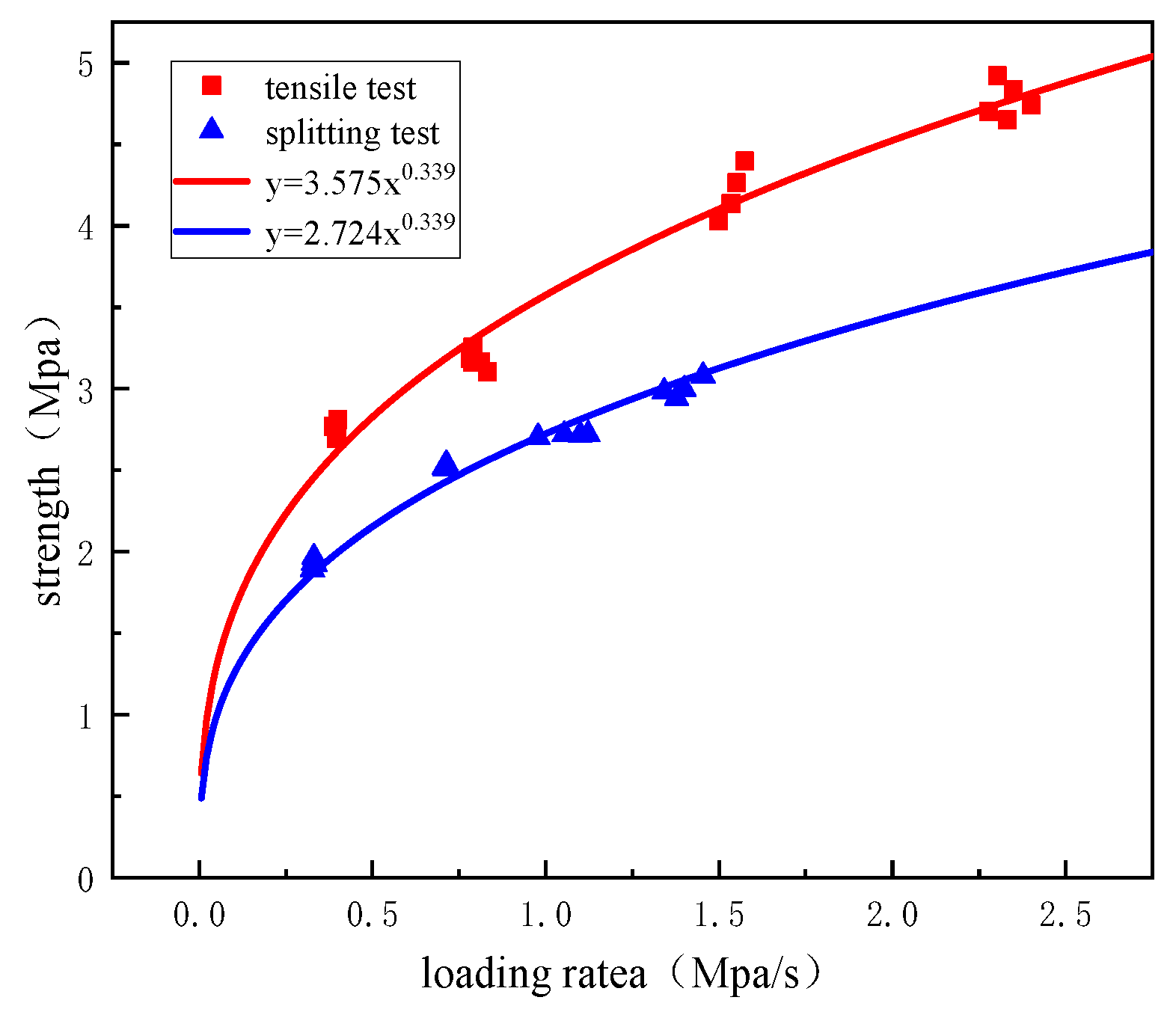
| Technical Indicators | Technical Requirement | Unit | Detection Result | |
|---|---|---|---|---|
| Penetration (25 °C, 100 g, 5 s) | 30~55 | 0.1 mm | 53 | |
| Penetration index PI | ≥0 | — | 0.21 | |
| Softening point (global method) | ≥75 | °C | 86 | |
| Ductility (5 °C, 5 cm/min) | ≥25 | cm | 31 | |
| Kinematic viscosity 135 °C | ≤3 | Pa·s | 2.2 | |
| Flash point (COC) | ≥230 | °C | 293 | |
| Solubility (trichloroethylene) | ≥99 | % | 99.6 | |
| Elastic recovery (25 °C) | ≥85 | % | 98 | |
| Rotating film oven test (163 °C, 85 min) | Ductility (5 °C) | ≥15 | cm | 17 |
| Mass loss | ≤±1.0 | % | 0.1 | |
| Penetration ratio (25 °C) | ≥65 | % | 67 | |
| Test Item | Unit | Technical Requirement | Test Result | |||
|---|---|---|---|---|---|---|
| 2.36~4.75 mm | 4.75~9.5 mm | 9.5~13.2 mm | 13.2~16 mm | |||
| Crushing value | % | ≤26 | 10.1 | 10.7 | 11.3 | 11.8 |
| Los Angeles abrasion value | % | ≤28 | 11.2 | 12.8 | 13.9 | 14.2 |
| Apparent relative density | — | ≥2.6 | 2.701 | 2.703 | 2.709 | 2.720 |
| Gross volume Relative density | — | — | 2.649 | 2.660 | 2.686 | 2.698 |
| Water absorption | % | ≤2 | 1.35 | 1.23 | 0.98 | 1.11 |
| Robustness | % | ≤12 | 2.1 | 2.9 | 3.1 | 3.2 |
| Needle and flake content | % | ≤15 | 11.3 | 9.0 | 8.8 | 7.1 |
| Polish value | PSV | ≥42 | 45.9 | 47.2 | 47.6 | 46.5 |
| Soft rock content | % | ≤3 | 1.2 | 1.6 | 2.1 | 1.3 |
| Gradation Type | Mass Percentage (%) Passing through the Following Sieve Openings (Square Sieve, mm) | |||||||||
|---|---|---|---|---|---|---|---|---|---|---|
| 16 | 13.2 | 9.5 | 4.75 | 2.36 | 1.18 | 0.6 | 0.3 | 0.15 | 0.075 | |
| AC-13 | 100 | 95 | 74 | 48.5 | 34 | 23.5 | 15 | 11 | 8.5 | 6 |
| Oil Stone Ratio/% | Gross Volume Relative Density/g·cm−3 | Void Fraction/% | Saturation/% | Mineral Aggregate Porosity/% | Stability/kN | Stream Value/0.1 mm |
|---|---|---|---|---|---|---|
| 4.77 | 2.465 | 3.8 | 72.1 | 14.1 | 13.3 | 29.2 |
| Specimen Number | MTS Peak Load/kN | MTS Moment of Peak Force/s | Channel 1 Failure Time of Strain Gauge/s | Channel 2 Failure Time of Strain Gauge/s | Channel 3 Failure Time of Strain Gauge/s | Channel 4 Failure Time of Strain Gauge/s |
|---|---|---|---|---|---|---|
| I-1.1-3 | 20.268 | 2.051 | 3.063 | 3.125 | 3.594 | 4.125 |
| I-1.1-8 | 24.928 | 1.924 | 3.344 | 3.344 | 4.125 | 3.313 |
| I-1.1-13 | 23.754 | 2.520 | 4.125 | 3.938 | 3.625 | 3.125 |
| I-1.1-35 | 23.569 | 2.178 | 3.439 | 3.758 | 3.495 | 3.652 |
| I-1.1-40 | 24.167 | 2.264 | 3.650 | 3.794 | 3.738 | 3.813 |
| I-1.1-42 | 22.222 | 3.018 | 4.031 | 3.625 | 4.844 | 4.313 |
| I-1.1-43 | 21.501 | 2.305 | 3.719 | 3.438 | 4.094 | 4.125 |
| I-1.1-49 | 23.445 | 2.334 | 6.250 | 7.469 | 3.063 | 3.125 |
| I-1.1-55 | 23.217 | 2.676 | 6.188 | 0.875 | 6.031 | 4.281 |
| I-1.1-57 | 23.609 | 1.885 | 2.974 | 3.530 | 2.986 | 3.717 |
| I-1.1-65 | 23.223 | 2.061 | 3.553 | 4.178 | 3.703 | 3.678 |
| I-1.1-68 | 23.485 | 1.963 | — | 3.656 | 3.199 | 3.594 |
| I-1.1-91 | 23.647 | 2.898 | 4.293 | 4.356 | 4.168 | 4.449 |
| I-1.1-93 | 21.830 | 2.051 | 5.031 | 4.969 | 3.719 | 3.813 |
| I-1.1-98 | 22.989 | 2.879 | 4.594 | 4.794 | 4.644 | 4.648 |
| Number of Specimens | Representative Working Conditions | Statistical Results of Peak Load | |||
|---|---|---|---|---|---|
| Average Value/kn | Standard Deviation | Variance | Variation Coefficient | ||
| 15 | Undifferentiated central or top cracks | 23.057 | 1.171 | 1.372 | 0.050 |
| 9 | Top cracks first | 22.739 | 1.407 | 1.979 | 0.062 |
| 6 | Central cracks first | 23.534 | 0.403 | 0.162 | 0.017 |
| Specimens Size (mm) | Statistical Results of Time Difference | |||
|---|---|---|---|---|
| Average Value | Standard Deviation | Variance | Variation Coefficient | |
| 63.5 | 1.369 | 0.216 | 0.047 | 0.158 |
| 50 | 1.146 | 0.478 | 0.229 | 0.417 |
| 35 | 0.966 | 0.152 | 0.023 | 0.157 |
| Test Number | Improvement Strategy | Number of Parallel Tests | Test Success Rate |
|---|---|---|---|
| I | 3 mm rubber gasket + rigid pressing plate | 6 | 33.3% |
| II | 1 mm rubber gasket + rigid pressing plate | 7 | 28.6% |
| III | 10 mm rubber gasket + 12.7 mm arc-shaped batten | 15 | 40% |
| IV | 1 mm rubber gasket + 12.7 mm arc-shaped batten | 7 | 28.6% |
| V | 0.5 mm rubber gasket + 12.7 mm arc-shaped batten | 12 | 16.7% |
| VI | 0.3 mm rubber gasket + 12.7 mm arc-shaped batten | 12 | 41.7% |
| Name | Value | Standard Error | T-Value | Probability > |t| |
|---|---|---|---|---|
| 3.575 | 0.039 | 91.631 | 0 | |
| 0.020 | 132.638 | 0 | ||
| 0.339 | 0.016 | 20.754 | 1.844 × 10−12 |
Disclaimer/Publisher’s Note: The statements, opinions and data contained in all publications are solely those of the individual author(s) and contributor(s) and not of MDPI and/or the editor(s). MDPI and/or the editor(s) disclaim responsibility for any injury to people or property resulting from any ideas, methods, instructions or products referred to in the content. |
© 2024 by the authors. Licensee MDPI, Basel, Switzerland. This article is an open access article distributed under the terms and conditions of the Creative Commons Attribution (CC BY) license (https://creativecommons.org/licenses/by/4.0/).
Share and Cite
Guan, H.; Pan, W.; Yang, H.; Yang, Y. Improvement of the Cracking Moment-Based Asphalt Mixture Splitting Test Method and Splitting Strength Research. Buildings 2024, 14, 457. https://doi.org/10.3390/buildings14020457
Guan H, Pan W, Yang H, Yang Y. Improvement of the Cracking Moment-Based Asphalt Mixture Splitting Test Method and Splitting Strength Research. Buildings. 2024; 14(2):457. https://doi.org/10.3390/buildings14020457
Chicago/Turabian StyleGuan, Hongxin, Wang Pan, Hairong Yang, and Yuxuan Yang. 2024. "Improvement of the Cracking Moment-Based Asphalt Mixture Splitting Test Method and Splitting Strength Research" Buildings 14, no. 2: 457. https://doi.org/10.3390/buildings14020457




